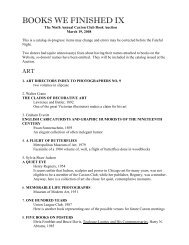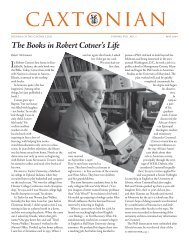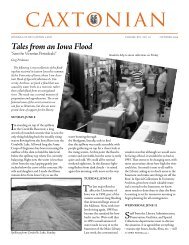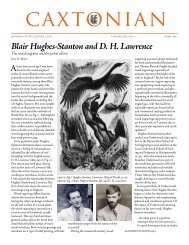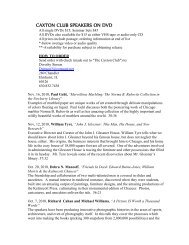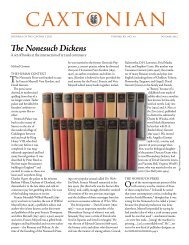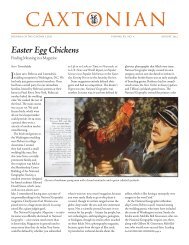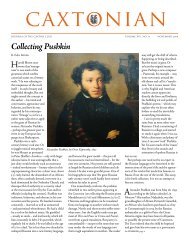July - The Caxton Club
July - The Caxton Club
July - The Caxton Club
You also want an ePaper? Increase the reach of your titles
YUMPU automatically turns print PDFs into web optimized ePapers that Google loves.
oC A X T O N I A N<br />
<strong>Caxton</strong> <strong>Club</strong>, Founded 1895<br />
David S. Mann, President<br />
Wendy Cowles Husser, Vice-President<br />
Bruce H. Boyer, Secretary<br />
Thomas E. Swanstrom, Treasurer<br />
C. Steven Tomashefsky, Past<br />
President<br />
Council<br />
Class of 2010<br />
Dorothy J. Anderson<br />
Don Chatham<br />
Mary Ann Johnson<br />
Philip R. Liebson<br />
J. William Locke<br />
Class of 2011<br />
Martha Chiplis<br />
Jill Gage<br />
Bradley Jonas<br />
Dan “Skip” Landt<br />
Alice D. Schreyer<br />
Class of 2012<br />
Susan Hanes<br />
Jon Lellenberg<br />
Margaret Oellrich<br />
Morrell McKenzie Shoemaker, Jr.<br />
Mary S. Williams<br />
Appointed Officers<br />
Robert Karrow, Programs<br />
Paul F. Gehl, Archivist-Historian<br />
Hayward R. Blake, FABS<br />
Representative<br />
Committees<br />
Margaret Oellrich, Audio Visual<br />
J. William Locke, Dorothy Sinson<br />
(Co-Chairs), Friday Luncheons<br />
Dan “Skip” Landt, Membership<br />
Susan Rossen, Kim Coventry,<br />
Publications and Exhibitions<br />
Martha Chiplis, Scholarship<br />
John M. Dunlevy, Matthew Doherty,<br />
Web Site and Directory<br />
<strong>Caxton</strong> <strong>Club</strong> Staff<br />
Dan Crawford, General Manager<br />
<strong>Caxton</strong>ian<br />
Robert McCamant, Editor<br />
Brenda Rossini, Copy Editor<br />
Robert Cotner, Founder<br />
Matthew J.Doherty, Wendy Husser,<br />
Paul Ruxin, Florence Shay,<br />
Contributing Editors<br />
©2010, <strong>Caxton</strong> <strong>Club</strong>. <strong>The</strong> <strong>Caxton</strong>ian is published<br />
monthly by the <strong>Caxton</strong> <strong>Club</strong>, whose office is<br />
in <strong>The</strong> Newberry Library. Printing: Kelmscott<br />
Communications, Aurora, IL.<br />
SHERLOCK HOLMES, from page 1<br />
Holmes constantly advanced with his brilliant interventions.<br />
In <strong>The</strong> Sign of the Four: Holmes: “I am the<br />
last and highest court of appeal in detection. When<br />
Gregson or Lestrade or Athelney Jones are out of<br />
their depths (which, by the way, is their normal state)<br />
the matter is laid before me.”<br />
<strong>The</strong> identity of Jack the Ripper remains in doubt,<br />
but the play of fiction and fact always fascinates. In<br />
this case, Holmes deploys Jack the Ripper dressed<br />
as a woman, one of his many ingenious disguises.<br />
<strong>The</strong> conclusion is remarkable. Unlike any of the<br />
Holmes stories in the Canon, except one, Holmes is<br />
saved by Watson, who, at the last moment, as Jack is<br />
about to advance on the unconscious Holmes with a<br />
nine-inch knife in an isolated courtyard, leaps from<br />
a wall and smashes Jack’s head against the cobblestones,<br />
knocking him out. In this case, it is Watson<br />
who has deduced the identity of the Ripper, from<br />
evidence that Inspector Athelney Jones had at one<br />
time attended lectures in surgery, and could have<br />
been the only one of three candidates to have heard a<br />
previously murdered woman singing “Sweet Violets.”<br />
He shadowed the Inspector and was there to save<br />
Holmes. “Holmes took his pipe from his mouth,” as<br />
Watson described his own deductions. “Extraordinary,<br />
my dear Watson,” exclaimed Holmes. “Elementary,<br />
my dear Holmes,” replied Watson. For those of<br />
you Sherlockians who have not remembered the one<br />
story in the Canon in which Watson saved Holmes’<br />
life, by shoving him out of a room with poisonous<br />
fumes, it was “<strong>The</strong> Adventure of the Devil’s Foot.”<br />
This contribution notwithstanding, Watson is mistaken<br />
by some readers as a bumbler, though adroit<br />
athletically, and remarkably supportive of Holmes.<br />
Although he overlooks clues, he doesn’t get in the<br />
way of the progress of Holmes’ deductions.<br />
It is generally concluded by Sherlockians that<br />
Holmes was born on January 6, 1854. <strong>The</strong> evidence<br />
for the year is that Holmes is described as a man<br />
of 60 in His Last Bow, which takes place in 1914.<br />
<strong>The</strong> date of January 6th is speculative. Among<br />
the credible reasons are two: in <strong>The</strong> Valley of Fear,<br />
Holmes appears unusually grumpy on the morning<br />
of January 7th, suggestive of a hangover. Some<br />
scholars concluded that Holmes had celebrated his<br />
birthday the night before. Another reason, perhaps<br />
less credible, was that Holmes liked to quote from<br />
Twelfth Night, which is, of course, the 6th of January.<br />
However, Conan Doyle himself did not provide a<br />
clue. How could one rely on the author anyway <strong>The</strong><br />
Canon is filled with inconsistencies. <strong>The</strong> most notorious<br />
example is Watson’s war wound, suffered in<br />
Afghanistan from a Jezail bullet, which involved his<br />
shoulder in A Study in Scarlet, and his leg in <strong>The</strong> Sign<br />
of the Four. Given this example, there may be some<br />
question as to whether Holmes was really 60 in 1914.<br />
In science, a hypothesis is made after careful<br />
examination of observations. <strong>The</strong> purpose of the<br />
hypothesis is to test a possible connection, a cause<br />
and effect relationship that explains the workings of<br />
a small part of the universe. <strong>The</strong> more focused the<br />
hypothesis-testing, the more likely statistical evaluation<br />
will prove a result for or against the hypothesis.<br />
An interesting thing about scientific hypotheses<br />
is that the experiment to test the hypothesis also<br />
attempts to disprove what is called a null-hypothesis,<br />
which is that the results, if they are significant statistically,<br />
were not due to chance alone. (Even if this<br />
is determined to be so, there is always the possibility<br />
that a putatively proven hypothesis may be due to<br />
bias in setting up the experiment.)<br />
Doyle was writing in the 19th and early 20th<br />
centuries, before this form of statistical analysis was<br />
commonly used. But Holmes nonetheless predicted<br />
some of these considerations in his science of deduction.<br />
“We must fall back upon the old axiom that<br />
when other contingencies fail, whatever remains,<br />
however improbable, must be the truth.” [“<strong>The</strong><br />
Adventure of the Bruce-Partington Plans”] Here,<br />
indeed, is an expression of the null-hypothesis in<br />
Holmes’ terms.<br />
Much like a contemporary scientific researcher,<br />
Holmes begins with a series of related observations<br />
before he can develop a hypothesis. In “A Scandal in<br />
Bohemia,” he will not interpret without appropriate<br />
observation: “I have no data yet. It is a capital<br />
mistake to theorize before one has data. Insensibly<br />
one begins to twist facts to suit theories, instead of<br />
theories to suit facts.” This perfectly describes the<br />
problem of bias in scientific evaluation.<br />
Unlike the scientist, who tests observations by<br />
performing controlled studies to determine<br />
whether one intervention produces a desired result,<br />
Holmes analyzes meaning after collecting all the<br />
information possible. In <strong>The</strong> Hound of the Baskervilles,<br />
as an example, Holmes studies the dead corpse<br />
of Sir Charles Baskerville. A problem is stated: How<br />
did Sir Charles die A hypothesis is developed. <strong>The</strong><br />
man either died of a heart attack or by a dog. <strong>The</strong><br />
research process requires Watson to spend time<br />
openly in the Baskerville home, keeping a diary,<br />
while Holmes himself, as we discover later, secretly<br />
spends time in a secluded cave on the moor and<br />
visits the nearby village, collecting data. Holmes concludes<br />
from his analysis that only Stapleton could<br />
have been the killer for the plausible reason that he<br />
wanted the family wealth for himself. However, he<br />
has to test this hypothesis by a final and dangerous<br />
experiment, set up so that Stapleton is provoked to<br />
release his hound to attack the younger Baskerville.<br />
Such experiments are common in the field of detective<br />
literature, whereas scientific investigation involving<br />
humans is usually bolstered with safeguards.<br />
This is not always the case. I was involved in a<br />
<strong>The</strong> <strong>Caxton</strong> <strong>Club</strong> • 60 W. Walton St., Chicago, IL 60610-3305 • ph 312-255-3710 • caxtonclub@newberry.org • www.caxtonclub.org




